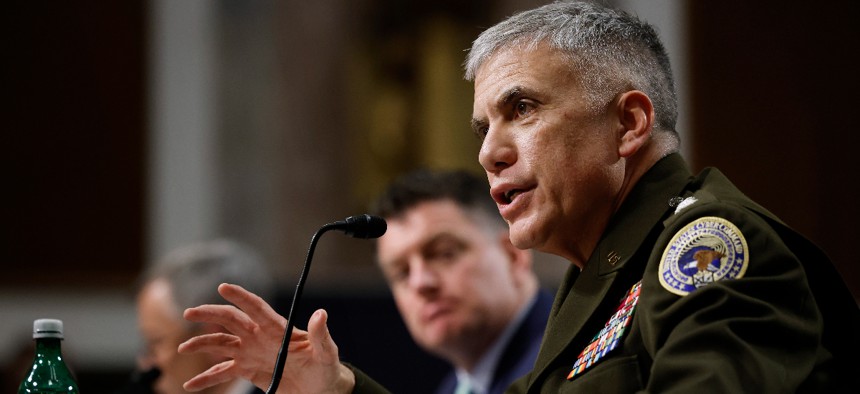USCYBERCOM’s Operations Have Strengthened Allies, Agency Lead Says

U.S. Army Gen. Paul Nakasone, commander of U.S. Cyber Command and director of the National Security Agency, testifies before the Senate Armed Services Committee in the Dirksen Senate Office Building on Capitol Hill on March 07, 2023 in Washington, DC. Chip Somodevilla/Getty Images
Gen. Paul Nakasone, commander of U.S. Cyber Command, told members of the Senate Armed Services Committee that the agency’s cyber partnerships have helped to build “tremendous confidence between nations.”
Enhanced partnerships with federal agencies and international allies have allowed the U.S. to effectively deter cyber threats from hostile nation-state actors, but the government needs to further expand its pool of talented cyber professionals to keep pace with global adversaries, the head of U.S. Cyber Command—or USCYBERCOM—said during a Senate Armed Services Committee hearing on Tuesday.
Gen. Paul Nakasone, USCYBERCOM’s commander and the director of the National Security Agency, told lawmakers that “success for U.S. Cyber Command will be measured by how effectively foreign adversarial actors are prevented from achieving their strategic objectives.” To achieve this mission, Nakasone said USCYBERCOM is continuing to focus “on our people, our partners and our ability to deliver decisive advantage”—which has been bolstered in recent years by the command’s work to strengthen the digital resilience of allied nations through information sharing and defensive cyber partnerships.
Nakasone cited the success of USCYBERCOM’s “hunt forward” operations, which the agency refers to as “strictly defensive cyber operations” that are carried out by personnel at the request of partner nations “to observe and detect malicious cyber activity on host nation networks.”
Nakasone said that hunt forward has built “tremendous confidence between nations” since it launched in 2018, including undertaking 47 different missions in 22 countries, as of Tuesday's hearing.
“When the United States deploys a hunt forward team to country X, country X knows that the United States cares,” Nakasone said, adding that it allows USCYBERCOM to “work with a partner, to understand their requirements and then also build a higher bar of cybersecurity.”
Sen. Jacky Rosen, D-Nev., said lawmakers have received positive feedback about USCYBERCOM’s hunt forward operations, telling Nakasone that “you show up and we work in partnership with others to help potentiate what they’re doing to protect themselves.”
Nakasone also credited the agency’s hunt forward operations with helping to counter Moscow’s use of more effective and damaging cyber tactics in Ukraine, even before Russian President Vladimir Putin launched his full-scale invasion of the country in February 2022.
Nakasone told Sen. Roger Wicker, R-Miss.—the panel’s ranking member—that USCYBERCOM’s deployment of a hunt forward team to Kyiv in December 2021 kicked off “a 70-day journey for us to ensure that Ukraine was at a much higher state of cyber readiness.”
“What we were able to do during that time was work with a series of partners to bring the tools and technology to Ukraine that were able to assist them as Russia conducted continued attacks,” he added.
Although Russia’s lack of successful far-reaching or crippling cyberattacks related to its invasion of Ukraine has surprised some security experts, officials remain concerned that the war’s ongoing stalemate could push Moscow to escalate its digital operations. Wicker asked Nakasone if he expects that Russia will be able “to intensify new capabilities in a spring offensive this year.”
"From a cyber perspective, we're watching this very carefully," Nakasone said, calling Russia a “very capable adversary” and adding that USCYBERCOM is working with federal partners—including the Cybersecurity and Infrastructure Security Agency and the FBI—to safeguard critical infrastructure in the U.S., as well as with international partners like NATO to “ensure they’re aware of the tradecraft the Russians might use.”
Sen. Jack Reed, D-R.I.—the panel’s chairman—used his opening remarks to commend USCYBERCOM and the U.S. intelligence community for their efforts in helping Ukraine “defend itself against both kinetic and cyber assaults” from Russia, calling it “a great example of competing effectively in the information domain.” But Reed expressed concern about the shortage of trained professionals across USCYBERCOM’s cyber mission force, in particular, noting that “the private sector has realized the immense value of our cyber operators and is offering them very high compensation to leave the military.”
Reed told Nakasone that the military services should provide “qualified and trained personnel to your command at the beginning of their tours so both the personnel and the command can take full advantage of the time in assignment,” adding that the services must also “adjust accordingly by providing a creative combination of incentives to compete for and retain these personnel.”
Nakasone said the readiness of the command’s 133 cyber mission teams—and ensuring they are staffed by highly-trained professionals—comes down to “the recruiting piece of it, the training piece of it and the retention piece of it.” While he said this type of work does make trained professionals attractive to the private sector, he added that working to keep personnel on-target when it comes to their cyber missions has proven beneficial to the command’s retention efforts.
“Several of the services—the marines included—have made tremendous progress in this, in being able to focus their marines on doing what these marines wanted to do, which is cyber operations,” Nakasone said. “And being able to stay within our force for long periods of time, we see a reflective retention rate that’s much higher.”
Nakasone said during the hearing that he was “really pleased” with the national cybersecurity strategy released by the Biden administration on March 2, which included a focus on “developing a diverse and robust national cyber workforce” and “increasing the capacity of our partners to defend themselves against cyber threats.” Nakasone added that the Defense Department will soon be releasing its own cybersecurity strategy, which he said will complement the White House’s approach.
Nakasone’s appearance before the committee also cleared up some questions around the future of the dual-hat leadership structure of the NSA and USCYBERCOM, which have shared the same leader since the command was established in 2010. Some lawmakers have expressed concern that the shared role is too much for one person to handle, and that the agencies use collected intelligence to carry out different missions.
In his written testimony, Nakasone said that a recently completed high-level report that has not yet been made public—which was conducted by a senior steering group at the direction of Defense Secretary Lloyd Austin and Director of National Intelligence Avril Haines—found “substantial benefits that present compelling evidence for retaining the existing structure.”






